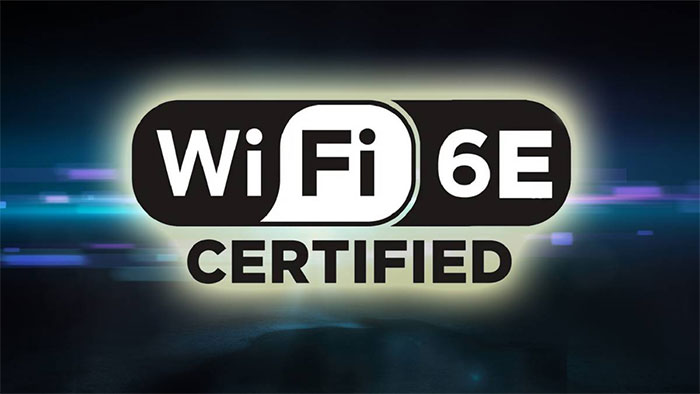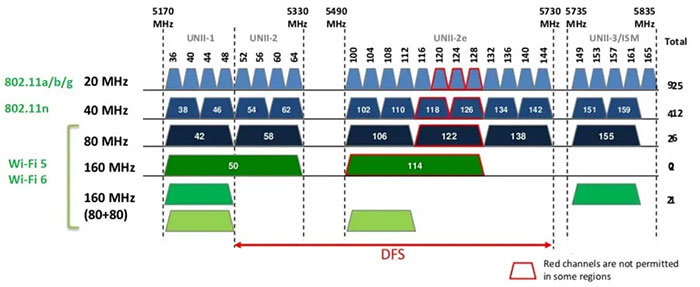Things to know about Wi-Fi 6E coming soon
You have probably heard of Wi-Fi 6E recently. This article will summarize some information about this new Wi-Fi standard and answer some frequently asked questions about it.
All about Wi-Fi 6e standard
So what is Wi-Fi 6E?
In short, Wi-Fi 6E is an extended version of Wi-Fi 6, operating on the 6 GHz band instead of the traditional 2.4 GHz and 5 GHz bands.

Wi-Fi 6E is an extended version of Wi-Fi 6.
In addition, it has all the features of the Wi-Fi 6 standard, including OFDMA and Target Wake Time (TWT). The speed is the same. The transmission speed is 600 Mbps on 80 MHz channels or 1200 Mbps on 160 MHz channels.
Why do we need 6E?
No, we don't need 6E, we want it.
To achieve the highest connection speed, Wi-Fi 6 needs to operate on 160 MHz channel, or at least 80 MHz. Only the 5 GHz band has so much space, but we only have a few 160 MHz channels, exactly two channels for the US. The remaining is the space for narrower channels such as 40 MHz and 20 MHz.
Because many Wi-Fi-only devices can only use 40 MHz and 20 MHz channels, all home networks face the problem of compatibility and performance.

Table comparing widths between 160 MHz channels with other channels. (Image: Michal Jarski)
Wi-Fi 6E overcomes this situation by using the entire band it has, the hardware of this standard can provide 7 new 160 MHz channels, or 14 80 MHz channels. As a result, the Wi-Fi 6E device will be able to function freely without having to worry about compatibility issues with older devices, as no older devices will be compatible.
To make things easier to understand, imagine the Wi-Fi network band is a road, channels are lanes, and the problem we are having is that 2.4 GHz has only small lanes for bicycles; 5 GHz uses larger lanes for cars, buses and trucks; and 6 GHz (Wi-Fi 6E) only has rails dedicated to bullet trains.
And that was the birth of Wi-Fi 6E.
Wi-Fi 6E will need new hardware
To use the 6 GHz band, you will need a new transmitter (router) and access devices (such as phones, computers .) must support the new standard. Similar to the fact that you can't ride a bicycle, motorbike, or car on the bullet train tracks. Therefore, no current Wi-Fi-enabled device, including Wi-Fi 6, can operate on this new band.
Initially, there were rumors that the Wi-Fi 6 router had built-in hardware for Wi-Fi 6E and would activate via firmware update. However, later, it seems that this rumor is false.
It will take a transition period like the transition period from single band (2.4 GHz) to two bands (2.4 GHz + 5 GHz) when the Wi-Fi 4 standard was launched in 2009.
A new device with three bands
Similar to the above case, to be compatible with old devices, the Wi-Fi 6E routers will also provide the 5 GHz band and possibly 2.4 GHz. In other words, maybe the new router will work on all three bands.
There are also routers that offer three bands such as Asus GT-AX11000, Netgear RAX200 or TP-Link AX11000. But these devices have only one 2.4 GHz band and two 5 GHz bands, the main purpose is to solve the bandwidth problem.
Come to think of it, we'll soon have a quad-band router when those above add 6 GHz.
Because Wi-Fi connection only takes place on one band at a time, on the customer side, we only need two bands (2.4 GHz + 5 GHz). However, with the arrival of the 6 GHz band, future receivers will also support all three bands (2.4 GHz + 5 GHz + 6 GHz).
The reason is that for the 6 GHz band to be widely available, network providers need to keep compatibility between devices, whether on what band or at what time. And the solution to combine multiple bands in the same hardware is the best solution.
Wi-Fi 6E and other Wi-Fi standards

Does the Wi-Fi 6E standard have any drawbacks?
Have. And certainly the narrower coverage is one of them.
In the world of radio waves, higher frequency waves always mean lower coverage. FM and AM radio use the MHz band, much lower than the Wi-Fi network.
The 5 GHz band obviously has less coverage than the 2.4 GHz band. Therefore, the coverage of the 6 GHz band will be smaller than the 5 GHz band, but it is still unclear what the actual difference is. But poor coverage means that this band is not suitable to be the main generator for a grid network.
Another conspicuous drawback is the price. Hardware for tri-band or quadband requires more components and it will definitely be more expensive. Again, keep in mind that you need both a transmitter and a terminal that supports the Wi-Fi 6E standard to use it.
When will devices that support the Wi-Fi 6E standard appear on the market?
The Wi-Fi Alliance introduced Wi-Fi 6E for the first time in early 2020. In April, the FCC approved the use of the 1.2 GHz spectrum for the 6 GHz band.
You can expect that the router supports Wi-Fi 6E from network providers will be sold by the end of 2020. Both Asus and Netgear have said they will launch the first product using the 6 GHz band in Last year.
On the consumer side, you will probably have to wait much longer, possibly to the next generation of phones and computers. Therefore, the earliest time you can use Wi-Fi 6E may be in the second half of 2021.
And until then, you should accumulate money to upgrade your computer hardware to be able to use the new Wi-Fi standard.

Even the most modern devices do not support the 6 GHz band.
Conclusion
You see, the Wi-Fi 6E is very close to us.
You will see more details and glorification of this new Wi-Fi standard soon. The all-new 6 GHz band will probably be an effective advertising tool, who doesn't want a faster Wi-Fi network?
Telecom service providers will take this opportunity and offer as many advantages of the 6E Wi-Fi standard for advertising, such as the new Wi-Fi standard that will support 8K, VR, and 5G video viewing. , with low latency, online game support, etc. and so on. Some of that information is accurate, but most have been exaggerated to attract customers.
The truth is we really don't know how Wi-Fi 6E will affect it until it's actually used. Until now, only one thing is for sure that you cannot use the Wi-Fi 6E standard on any device already and available on the market. This is probably the most losing information about the Wi-Fi 6E standard.
So, don't expect too much of the arrival of Wi-Fi 6E, just keep using the devices that are supporting you every day. Before choosing to upgrade to a new standard, it's best to wait for it to be widely available first.
- 12 hottest things in the universe
- Detecting maggots coming out of the leg after the tour
- Bad things always remember longer than good
- 12 horrible things about China you may not know
- 10 interesting things about life you may not know
- Strange facts about death
- 9 things are more important than money
- 7 impressive things you don't know about Uzbekistan
- Things you didn't know about Bahrain kingdom
- 10 interesting things about nature you may not know
- Make a New Year greeting card with Halkmark Card Studio
- Steve Ballmer: The era of
 What is the Snapdragon SiP chip?
What is the Snapdragon SiP chip? How to create a yellow circle around the mouse cursor on Windows
How to create a yellow circle around the mouse cursor on Windows Edit the Boot.ini file in Windows XP
Edit the Boot.ini file in Windows XP 3 ways to restart the remote computer via the Internet
3 ways to restart the remote computer via the Internet Is public Wi-Fi less secure?
Is public Wi-Fi less secure?  What does the name Wi-Fi mean?
What does the name Wi-Fi mean?  Here's everything you need to know about Wi-fi 7
Here's everything you need to know about Wi-fi 7  To make your home Wi-Fi better, turn off the microwave
To make your home Wi-Fi better, turn off the microwave  Wi-Fi 6E is about to dock: what does it mean for us?
Wi-Fi 6E is about to dock: what does it mean for us?  It's time to change your home Wi-Fi network to live better
It's time to change your home Wi-Fi network to live better 